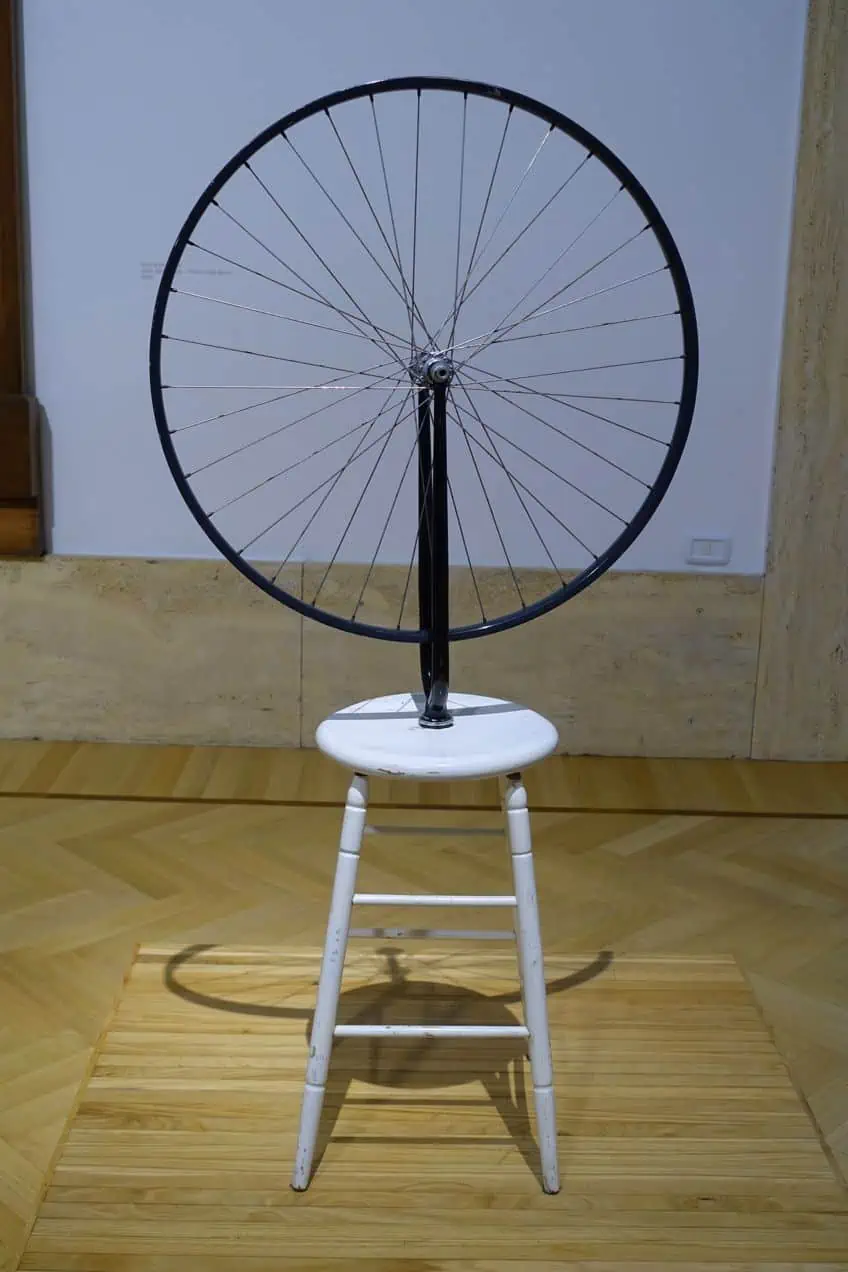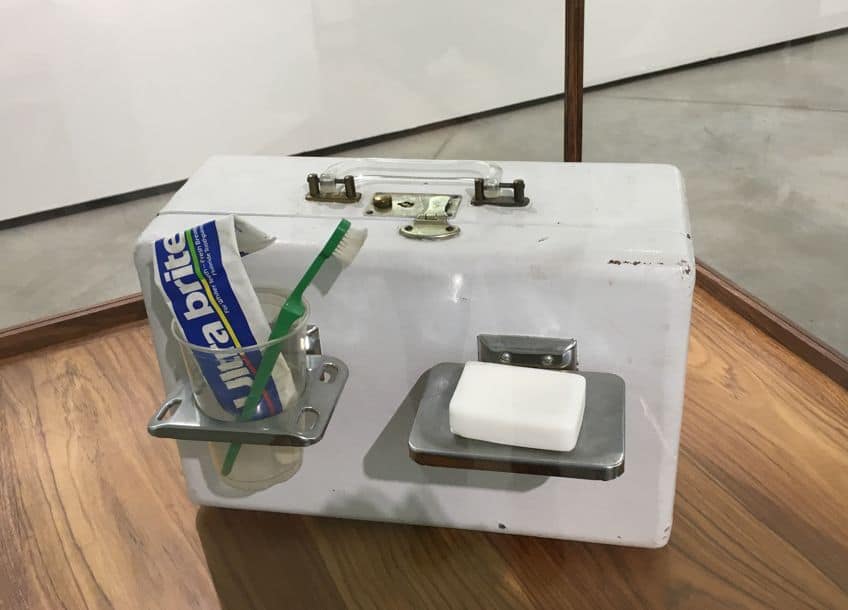Found Object Art – The Movement Behind Creating Found Art
Found object art, also known as readymade art or objet trouvé, is an art movement that emerged in the early 20th century. The term “found object” refers to everyday objects that are selected by an artist and presented in a new context as a work of art. In this article, we will answer the question: “what is found art?”. We will look at how this object art form started, and some famous examples of found object sculptures and other object artworks.
What Is Found Art: The History of Found Object Artworks
It is commonly accepted that this artistic approach was pioneered by Marcel Duchamp (1887 – 1968), who is considered the father of found object art. Marcel Duchamp began to experiment with found objects in the early 1910s. He was inspired by the works of the Dada artists, who rejected traditional art forms and sought to create works that were provocative and challenging. In 1913, Duchamp submitted a porcelain urinal to an exhibition in New York, signing it with the pseudonym “R. Mutt.” The work, entitled Fountain, was rejected by the exhibition organizers, but it sparked controversy and became one of the most important works of the 20th century. Duchamp’s use of a mass-produced object in an art context challenged traditional notions of art and forced viewers to question the nature of art itself.

Duchamp continued to use found objects throughout his career, creating works such as Bicycle Wheel (1913), Bottle Rack (1914), and In Advance of the Broken Arm (1915). He referred to these works as “readymades,” because they were already made and did not require any artistic skill or intervention. By selecting and presenting these objects in a new context, Duchamp transformed them into works of art that challenged traditional ideas about beauty, creativity, and authorship.
Object Art After Duchamp
Duchamp’s readymades inspired other artists to explore the potential of found objects in their own work. The Surrealists, for example, used found objects to create dreamlike and bizarre sculptures and assemblages. The artist Meret Oppenheim created Object (1936), a fur-covered teacup, saucer, and spoon that transformed everyday objects into sensual and surreal sculptures. The artist Kurt Schwitters created collages and assemblages out of found objects, creating complex compositions that explored the relationship between man-made objects and nature.
In the 1950s and 1960s, artists associated with the Pop Art movement began to use found objects as a way of commenting on consumer culture and mass production.
The artist Claes Oldenburg created sculptures of everyday objects such as hamburgers, typewriters, and toilets, using them to critique the excesses and absurdities of American society. Other artists, such as Robert Rauschenberg and Jasper Johns, incorporated found objects into their paintings, using them to challenge the boundaries between painting and sculpture.
Modern Found Art
Found object art has continued to be an important part of contemporary art. Artists such as Damien Hirst and Jeff Koons have created sculptures and installations using everyday objects, often with a focus on their commercial value and cultural significance. Other artists, such as Ai Weiwei and Kara Walker, have used found objects to explore issues of social justice, race, and identity.

Who Actually Invented the Ready Made?
Baroness Elsa von Freytag-Loringhoven, a German poet and artist, had a significant impact on Marcel Duchamp’s work, which has been largely overlooked in the history of art. Despite historians and art collectors debating her involvement in creating Fountain, some have found evidence suggesting that she discovered, signed, and submitted the piece. The Baroness was part of the same art scene in New York as Duchamp and was a close friend of his. Researchers have discovered a letter that Duchamp wrote to his sister Susanne, in which he tells the story of one of his female friends who found, signed, and submitted a piece of plumbing to the Society of Independent Artists’ first-ever exhibition, which could potentially prove that the Baroness was the creator of Fountain.
Additionally, R. Mutt, the pseudonym under which Fountain was submitted, was found to have been an artist living in Philadelphia, where the Baroness was also living at the time.

However, the story of the urinal’s creation is still debated, as the original artwork has been lost. Duchamp only claimed the work as his own in 1950, long after the death of the Baroness and four years after the death of the photographer Stieglitz. Even though André Breton credited Fountain to Duchamp in 1935, it was only 25 years later that he claimed it and began issuing replicas.
Duchamp claimed that he had purchased the urinal from JL Mott Ironworks Company and changed the name from Mott to Mutt. However, this company did not sell the model of the urinal in the photograph, and the Baroness collected pipes, drains, and spouts, regularly referring to plumbing in her poetry. The handwriting on the urinal also matched that in her poems. These are some of the historical clues that historians have found. Many artists and creatives over the years have reiterated this evidence, yet the world still credits Duchamp as the mastermind behind Fountain. One reason for this could be the art world’s tendency to praise and recognize male artists more easily than female artists.
Some historians even believe that Fountain may not have achieved its fame if the Baroness had been recognized as the artist from the beginning.
Examples of Found Object Sculpture
This artistic practice arose in response to the changing cultural landscape of the time, as artists sought to break free from traditional art forms and explore new and unconventional ways of creating art. Found object sculpture, also known as assemblage art or junk art, has its roots in the Dada movement and was later popularized by artists such as Marcel Duchamp, Pablo Picasso, and Robert Rauschenberg. In this section of the article, we will examine a few popular examples of found object sculpture.

Lobster Telephone (1936) by Salvador Dalí
| Artist | Salvador Dalí (1904 – 1989) |
| Date | 1936 |
| Medium | Found telephone and a lobster |
| Dimensions (cm) | 17,8 × 33 |
| Movement | Surrealism |
| Location | Tate Modern, London, United Kingdom |
Lobster Telephone is a surrealist sculpture created in 1936 by the famous Spanish artist Salvador Dalí. The artwork is a unique example of found object art, a technique that involves taking everyday objects and transforming them into art. We will analyze Lobster Telephone visually, contextualize it in Dali’s personal and professional life, and explore why this artwork was so revolutionary at the time of its creation.

Lobster Telephone: Analysis
Visually, Lobster Telephone consists of a real lobster placed on top of a black telephone. The telephone is an old-fashioned model with a rotary dial, and the lobster is placed in such a way that it covers part of the receiver. The lobster is an unusual choice for an art object and appears to be alive, but at the same time, it has a strange, almost mechanical quality to it.
The overall effect is both disturbing and intriguing.
Lobster Telephone: Context
In terms of its context, Lobster Telephone was created during a period of intense artistic and political upheaval. Dali was an important member of the Surrealist movement, which sought to challenge traditional modes of thinking and break down the boundaries between art and everyday life. He was also an outspoken critic of the rise of fascism in Europe and used his art to make political statements. Dali’s personal life was also marked by turmoil during this period. In 1934, he had been expelled from the Surrealist group for his support of fascism, and he had begun to develop a more individualistic approach to his art.
He was also deeply influenced by the psychoanalytic theories of Sigmund Freud (1856 – 1939), which emphasized the importance of the unconscious mind.
Lobster Telephone: Influence
Against this backdrop, Lobster Telephone was a groundbreaking work of art. By taking an ordinary object and transforming it into a work of art, Dali challenged the viewer’s expectations and forced them to question the nature of reality. The telephone, which was a symbol of communication and connection, was juxtaposed with the lobster, a symbol of irrationality and the unconscious. The effect was to create a surreal and unsettling image that challenged the viewer’s assumptions about the world.
 Lobster Telephone (1938) by Salvador Dalí; Nacaru, CC BY 4.0, via Wikimedia Commons
Lobster Telephone (1938) by Salvador Dalí; Nacaru, CC BY 4.0, via Wikimedia Commons
In addition to its innovative use of found objects, Lobster Telephone was also notable for its use of humor. Dali was known for his love of puns and wordplay, and the combination of the lobster and the telephone was a witty and unexpected juxtaposition. This humor helped to disarm the viewer and made them more receptive to the artwork’s deeper meanings.
Untitled (1949) by Joseph Cornell
| Artist | Joseph Cornell (1903 – 1972) |
| Date | 1949 |
| Medium | Wooden box containing glass, mirror, dye, and printed text on paper |
| Dimensions (cm) | 37.94 × 32.07 × 8.73 |
| Movement | Modern Art |
| Location | The Joseph and Robert Cornell Memorial Foundation, the University of Virginia, Charlottesville, United States |
Untitled is a surrealist artwork created in 1949 by the American artist Joseph Cornell. The artwork is a unique example of found object art. Here, we will analyze Untitled visually, contextualize it in Cornell’s personal and professional life, and explore why this artwork was so revolutionary at the time of its creation.
Untitled: Analysis
Visually, Untitled consists of a small wooden box with a glass front. The box contains a collection of found objects, including a metal spring, a thimble, a button, and a small paper cutout of a bird. The objects are arranged in a carefully composed scene that suggests a dreamlike landscape. The overall effect is both whimsical and mysterious.
Untitled: Context
In terms of its context, Untitled was created during a period of intense artistic and cultural change in America. Cornell was part of a group of artists known as the “New York School,” which included artists such as Jackson Pollock (1912-1956) and Mark Rothko (1903 – 1970). The New York School was known for its rejection of traditional art forms and its embrace of experimentation and improvisation. Cornell’s personal life was also marked by a sense of isolation and introspection. He lived with his mother and disabled brother in a small house in Queens, New York, and rarely left the city.
He was deeply influenced by the poetry of Emily Dickinson (1830-1886) and the writings of the French symbolist poet Stéphane Mallarmé (1842-1898), both of whom explored themes of isolation, imagination, and the mysteries of the subconscious.
Untitled: Influence
Against this backdrop, Untitled was a groundbreaking work of art. By taking a collection of found objects and transforming them into a carefully composed scene, Cornell challenged the viewer’s expectations and forced them to question the nature of reality. The objects in the box, which were typically associated with mundane, everyday life, were elevated to the status of art. The effect was to create a surreal and dreamlike image that challenged the viewer’s assumptions about the world.
In addition to its innovative use of found objects, Untitled was also notable for its use of metaphor and symbolism. Cornell was known for his love of literature and poetry, and his artworks often referenced themes and images from these sources. The bird in the box, for example, may have been inspired by Emily Dickinson’s poem Hope is the thing with feathers. This use of metaphor and symbolism helped to give the artwork a deeper, more profound meaning.
Electric Dress (1956) by Atsuko Tanaka
| Artist | Atsuko Tanaka (1962 – Present) |
| Date | 1956 |
| Medium | 200 electric bulbs, each painted by hand |
| Dimensions (cm) | 109.22 x 76.84 |
| Movement | Neo-Dada |
| Location | The Museum of Contemporary Art, Los Angeles, United States |
Electric Dress, created in 1956 by the Japanese artist Atsuko Tanaka, is a striking example of avant-garde art that used new materials and technologies to create a unique work of art. We will visually analyze Electric Dress, contextualize it in Tanaka’s personal and professional life, and explore why this artwork was so revolutionary at the time of its creation.
Electric Dress: Analysis
Visually, Electric Dress is a cylindrical sculpture made of brightly colored electric wires and bulbs. The wires are arranged in a circular pattern that forms a skirt-like shape, while the bulbs are placed in a diamond pattern that suggests the shape of a torso. The overall effect is both dazzling and futuristic, evoking the promise of a new era of technological innovation.
Electric Dress: Context
In terms of its context, Electric Dress was created during a period of rapid economic growth and technological development in Japan. Tanaka was part of a group of artists known as the “Gutai group,” which sought to push the boundaries of art by incorporating new materials and technologies into their work. The Gutai group believed in the power of individual expression and the importance of breaking with tradition. Tanaka’s personal life was also marked by a sense of experimentation and innovation.
She grew up in a family of artists and was deeply influenced by her mother’s work as a traditional Japanese painter. She studied art at the Kyoto City University of Arts, where she was exposed to a range of artistic styles and techniques.
Electric Dress: Influence
Against this backdrop, Electric Dress was a groundbreaking work of art. By using electric wires and bulbs to create a sculpture that evoked the shape of a dress, Tanaka challenged the viewer’s expectations and forced them to question the nature of art. The use of new materials and technologies also reflected the optimism and enthusiasm of the era, as Japan sought to position itself as a leader in the field of technology and innovation.
In addition to its use of new materials and technologies, Electric Dress was also notable for its use of color. Tanaka was known for her bold use of color, and Electric Dress is no exception. The bright pink, yellow, and green wires and bulbs create a dazzling and mesmerizing effect that captures the viewer’s attention and draws them into the artwork.
My Bed (1998) by Tracey Emin
| Artist | Tracey Emin (1963 – Present) |
| Date | 1998 |
| Medium | Box frame, bed, bedding, pillows and various found objects |
| Dimensions (cm) | N/A |
| Movement | Young British Artists |
| Location | Tate Modern, London, United Kingdom |
My Bed, created by Tracey Emin in 1998, is a highly controversial and visually striking work of art that has sparked debates about the definition of art and the role of the artist in contemporary society. In this section, we will visually analyze My Bed, contextualize it in Tracey Emin’s personal and professional life, and explore why this artwork was so revolutionary at the time of its creation.

My Bed: Analysis
Visually, My Bed is a highly personal and intimate work of art. It consists of a disheveled bed covered in stained sheets and surrounded by a variety of personal items, including cigarette butts, condoms, and empty bottles of alcohol. The overall effect is both unsettling and provocative, challenging the viewer’s expectations of what art should be and what it should represent.
My Bed: Context
In terms of its context, My Bed was created during a period of intense debate and controversy in the art world. Emin was part of a group of artists known as the “Young British Artists,” who sought to push the boundaries of art by incorporating personal experiences and emotions into their work. The group was known for its provocative and sometimes shocking artworks, which challenged traditional notions of beauty and aesthetic value. Emin’s personal life was also marked by a sense of turmoil and pain. She had a difficult childhood, marked by abuse and neglect, and struggled with addiction and mental health issues throughout her life.
My Bed is a deeply personal work of art that reflects these experiences and emotions, inviting the viewer to share in the artist’s pain and vulnerability.
My Bed: Influence
Against this backdrop, My Bed was a groundbreaking work of art. By using personal items and experiences to create a work of art, Emin challenged the viewer’s assumptions about the role of art and how it connects to beauty. The work also forced viewers to confront uncomfortable truths about themselves and the world around them, exposing the darker side of contemporary society and the human condition.
In addition to its provocative content, My Bed was also notable for its use of found objects. The use of everyday objects such as stained sheets and empty bottles challenged the notion that art must be beautiful or created using traditional art materials. g the complex and sometimes painful realities of contemporary life.
In conclusion, found object art emerged as a response to the changing nature of art in the early 20th century. By using everyday objects as works of art, artists challenged traditional ideas about creativity, authorship, and the nature of art itself. This approach has continued to be an important part of contemporary art, inspiring artists to create works that challenge our assumptions about the world around us.
Frequently Asked Questions
What Is Found Art?
Found art, also known as readymade art, is a form of art that involves taking everyday objects or materials and transforming them into works of art. The artist selects or finds the object or material, and may make slight modifications or additions to it to create a new, unique piece of art. The concept of found art challenges traditional ideas about what can be considered art, and often seeks to turn the mundane into something of aesthetic value. Famous examples of found art include Marcel Duchamp’s Fountain, which was a urinal that he submitted as a sculpture to an art exhibition in 1917.
Why Is Found Art Considered Controversial?
Found art, or readymade art, is often controversial because it challenges traditional notions of what art is supposed to be. By taking ordinary, everyday objects and presenting them as art, it can be difficult for some viewers to understand or appreciate the piece. Additionally, some people argue that found art requires little skill or creativity on the part of the artist, as they are not creating something entirely new from scratch. Others argue that found art is a reflection of the artist’s vision and creativity in selecting and presenting the object. Despite the controversy, found art has played an important role in the development of modern and contemporary art, and continues to be a popular and provocative form of artistic expression.
What Is an Example of Found Object Art?
Lobster Telephone is a significant work of art that reflects both the personal and professional context of the artist Salvador Dalí’s life. By using a found object in a novel way, Dalí challenged the boundaries between art and everyday life, and forced the viewer to question their assumptions about reality. The artwork’s use of humor also made it more accessible, and helped to make it a groundbreaking piece of surrealist art.
Nicolene Burger, a South African multimedia artist and creative consultant, specializes in oil painting and performance art. She earned her BA in Visual Arts from Stellenbosch University in 2017. Nicolene’s artistic journey includes exhibitions in South Korea, participation in the 2019 ICA Live Art Workshop, and solo exhibitions. She is currently pursuing a practice-based master’s degree in theater and performance. Nicolene focuses on fostering sustainable creative practices and offers coaching sessions for fellow artists, emphasizing the profound communicative power of art for healing and connection. Nicolene writes blog posts on art history for artfilemagazine with a focus on famous artists and contemporary art.
Learn more about Nicolene Burger and about us.
Cite this Article
Nicolene, Burger, “Found Object Art – The Movement Behind Creating Found Art.” artfilemagazine – Your Online Art Source. April 4, 2023. URL: https://artfilemagazine.com/found-object-art/
Burger, N. (2023, 4 April). Found Object Art – The Movement Behind Creating Found Art. artfilemagazine – Your Online Art Source. https://artfilemagazine.com/found-object-art/
Burger, Nicolene. “Found Object Art – The Movement Behind Creating Found Art.” artfilemagazine – Your Online Art Source, April 4, 2023. https://artfilemagazine.com/found-object-art/.


